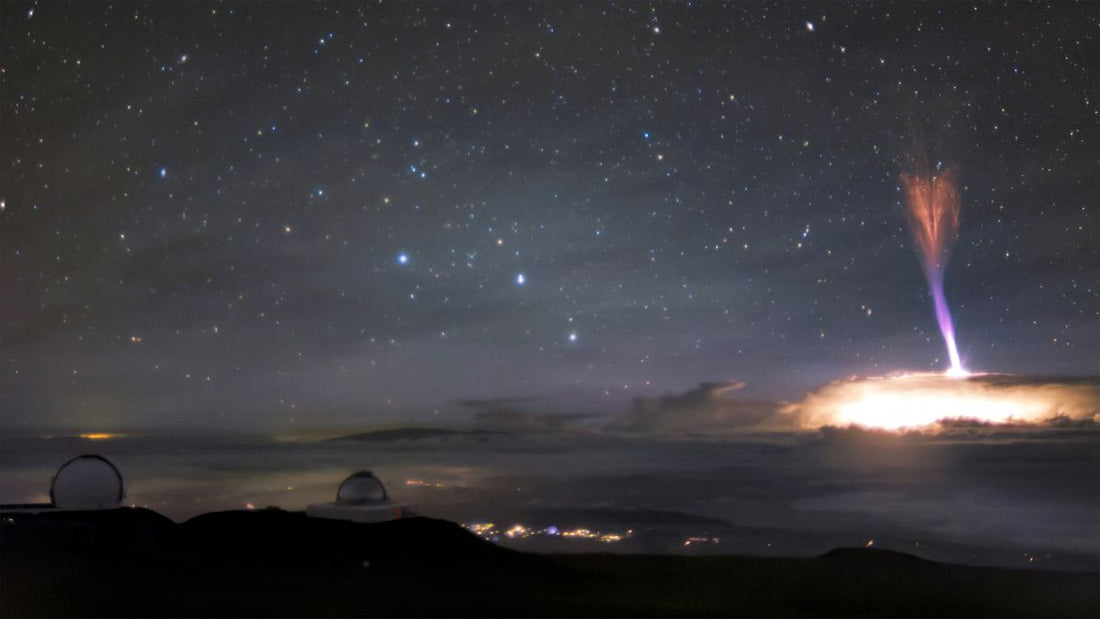
Ultra Rare Red Sprite And Blue Jet Caught Together In Once-In-A-Lifetime Shot
Share
First things first: what the hell are sprites and blue jets?
In no uncertain terms, we don't really know what the heck sprites are. We just know they look like huge red jellyfish that follow a lightning strikes in the mesosphere - about 50-80 km in the sky, above where shooting stars and meteors will break up.
Since 1989 we've understood that when lightning strikes the ground, charges are sent back into the sky obeying Newton's Third Law of action-reaction.
![]()
A rare red sprite high up in the mesosphere
While sprites seem majestic and uncommon, they happen quite a lot.
The problem is catching them on film as they are faster than the lightning strike itself, in the many tenths of a second. They move downward at speeds of up to 10% the speed of light, followed a few milliseconds later by a separate set of upward moving balls of ionization.
It is difficult to tell the size of sprites from an image because photographers must be several hundred kilometres away from the storm.

A blue jet atop a storm
Blue jets are another high altitude optical phenomenon much different than sprites and first documented in 1994 (although pilots had earlier reported similar sightings).
Blue jets are optical ejections fired from the top of the active core of thunderstorms at around 36,000 km/h, yet not directly associated with cloud-to-ground lightning. They typically grow upward in a narrow cone fanning out and disappearing at about 40-50 km altitude. Like red sprites, they have a finite lifetime of a couple of tenths of a second.
Here's footage of red sprites and a blue sprite caught from space thanks to ESA astronaut Andreas Mogensen.
We've known the two are closely intermingled, but now a Hawaiian observatory has caught the two within the same shot, making an unforgettably iconic image. The column of blue and red lights surrounded by a bright blaze of white light appears so otherworldly that it looks like it must be a special effect. This breathtaking image, however, is entirely real. It features the lightning phenomena named a red sprite.
Red Sprite And Blue Jet Caught Together

The Gemini Observatory in Hawaii captured both a red sprite and a blue jet in the same shot, released on Feb. 24
The "cloud cam" at the Gemini North Telescope captured the unity of red sprite and blue jet perfectly in this image. The modified consumer-grade DSLR had been customised to take photos within a millisecond after a lighting strike and the following 30 seconds from the roof of the observatory pointed towards the predicted direction of incoming storms.
The rooftop, about 4.2 km above sea-level, makes an powerful vantage point for captured high altitude phenomena.
Though sprites and jets are rarely witnessed from the ground, they're not uncommon above thunderstorms. In 2017, an astronaut aboard the International Space Station witnessed 245 blue flashes in just 160 seconds over one storm. Scientists debate whether these phenomena are simply transient or whether they have any lasting effects. For example, if their passage alters the chemistry of the upper atmosphere, they might have an effect on the ozone layer, researcher Hans Stenbaek-Nielsen of the University of Alaska at Fairbanks told Live Science in 2011.
Studying sprites and jets is difficult. Scientists take measurements from ground-based observatories and sometimes fly specially-instrumented research aircraft close to storms to detect them. But as the phenomena last just tens of milliseconds, they remain mysterious.
Thanks for reading gang!
If you love spreading ARSE, please share and comment in our official Australian Space Society like our mate Diane below.
Keep looking skywards!
#Space_Aus





